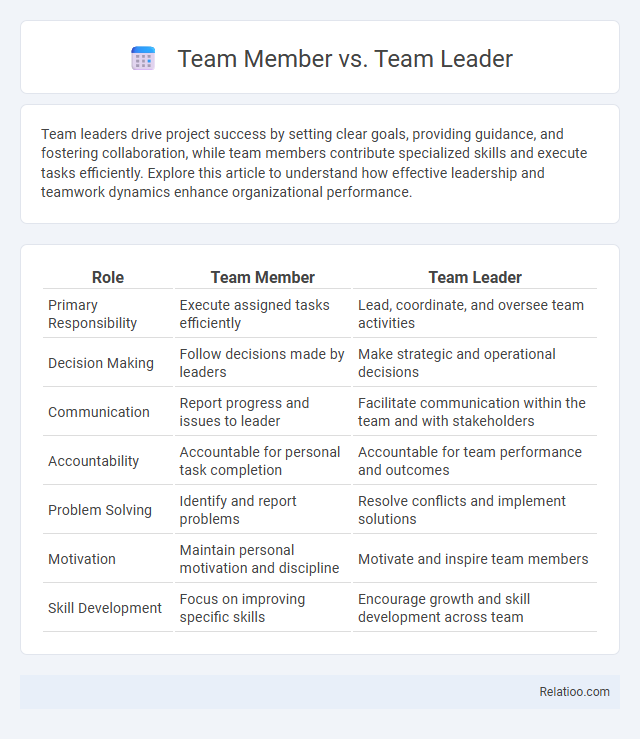Team leaders drive project success by setting clear goals, providing guidance, and fostering collaboration, while team members contribute specialized skills and execute tasks efficiently. Explore this article to understand how effective leadership and teamwork dynamics enhance organizational performance.
Table of Comparison
| Role | Team Member | Team Leader |
|---|---|---|
| Primary Responsibility | Execute assigned tasks efficiently | Lead, coordinate, and oversee team activities |
| Decision Making | Follow decisions made by leaders | Make strategic and operational decisions |
| Communication | Report progress and issues to leader | Facilitate communication within the team and with stakeholders |
| Accountability | Accountable for personal task completion | Accountable for team performance and outcomes |
| Problem Solving | Identify and report problems | Resolve conflicts and implement solutions |
| Motivation | Maintain personal motivation and discipline | Motivate and inspire team members |
| Skill Development | Focus on improving specific skills | Encourage growth and skill development across team |
Introduction to Team Member vs Team Leader
Team Members contribute specialized skills and collaborate on project tasks, while Team Leaders guide the group by setting priorities, motivating members, and resolving conflicts. Your role as a Team Leader involves establishing clear ground rules to ensure effective communication and accountability within the team. Understanding the distinctions between these roles improves project efficiency and fosters a productive team environment.
Defining the Roles: Team Member and Team Leader
Defining the roles of Team Member and Team Leader is essential for organizational clarity and productivity. Team Members contribute specific skills and complete tasks assigned, while Team Leaders guide, motivate, and oversee the team's progress towards goals. Establishing clear ground rules based on these roles ensures your team functions efficiently with mutual respect and defined responsibilities.
Key Responsibilities of a Team Member
A Team Member is responsible for actively contributing to group tasks, collaborating effectively with peers, and adhering to established ground rules that promote respect and accountability. Key duties include completing assigned work on time, providing constructive feedback, and supporting team goals to ensure project success. Maintaining clear communication and participating in problem-solving efforts are essential for fostering a productive team environment.
Core Duties of a Team Leader
A Team Leader is responsible for guiding and motivating team members, ensuring project objectives are met efficiently through clear communication and delegation. Core duties include setting team goals, monitoring progress, resolving conflicts, and fostering a collaborative work environment. Unlike team members who execute tasks, the leader aligns individual efforts with organizational priorities and maintains accountability for overall team performance.
Essential Skills: Team Member vs Team Leader
Team members must excel in communication, collaboration, and adaptability to contribute effectively within diverse groups. Team leaders require advanced skills in decision-making, conflict resolution, and motivation to guide teams toward achieving strategic objectives. Ground rules establish clear expectations, accountability, and respect, fostering a productive environment essential for both roles.
Leadership Qualities vs Collaborative Attributes
Team leaders exhibit strong leadership qualities such as decision-making, strategic thinking, and accountability, while team members emphasize collaborative attributes like open communication, adaptability, and supportiveness. Ground rules establish clear expectations that balance leadership authority with teamwork, promoting trust, respect, and effective conflict resolution among all participants. Your ability to integrate leadership strengths with collaborative behaviors enhances team performance and drives collective success.
Decision-Making: Who Leads, Who Supports?
Team leaders primarily drive decision-making by setting objectives and guiding team members toward goals, while team members contribute insights and execute tasks based on those decisions. Ground rules establish clear expectations for participation and communication, ensuring a structured process where leaders lead and members support effectively. Your team functions best when roles and decision-making authority are clearly defined, promoting collaboration and accountability.
Communication Styles in Both Roles
Team Members typically use communication styles that emphasize active listening, clear feedback, and collaborative dialogue to contribute effectively within the group. Team Leaders adopt more directive and motivational communication, focusing on setting expectations, providing guidance, and resolving conflicts to maintain team cohesion. Establishing Ground Rules ensures both roles understand preferred communication norms, promoting transparency and minimizing misunderstandings in Your team's interactions.
Impact on Team Dynamics and Performance
Team Members contribute specialized skills and support tasks that drive project momentum, directly influencing team efficiency and quality of outputs. Team Leaders shape team dynamics by providing direction, resolving conflicts, and fostering motivation, which enhances collaboration and overall performance. Establishing clear Ground Rules ensures consistent behavior and communication standards, reducing misunderstandings and promoting a productive, cohesive work environment.
Career Growth: Moving from Team Member to Team Leader
Advancing from a team member to a team leader requires developing leadership skills, effective communication, and decision-making capabilities. Understanding and enforcing ground rules enhances team productivity and fosters trust, which is essential for career growth and successful management. Mastering conflict resolution and motivating team members are critical steps to transition into leadership roles and drive project success.

Infographic: Team Member vs Team Leader
 relatioo.com
relatioo.com